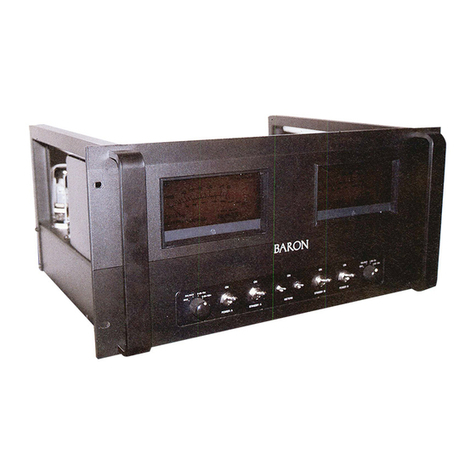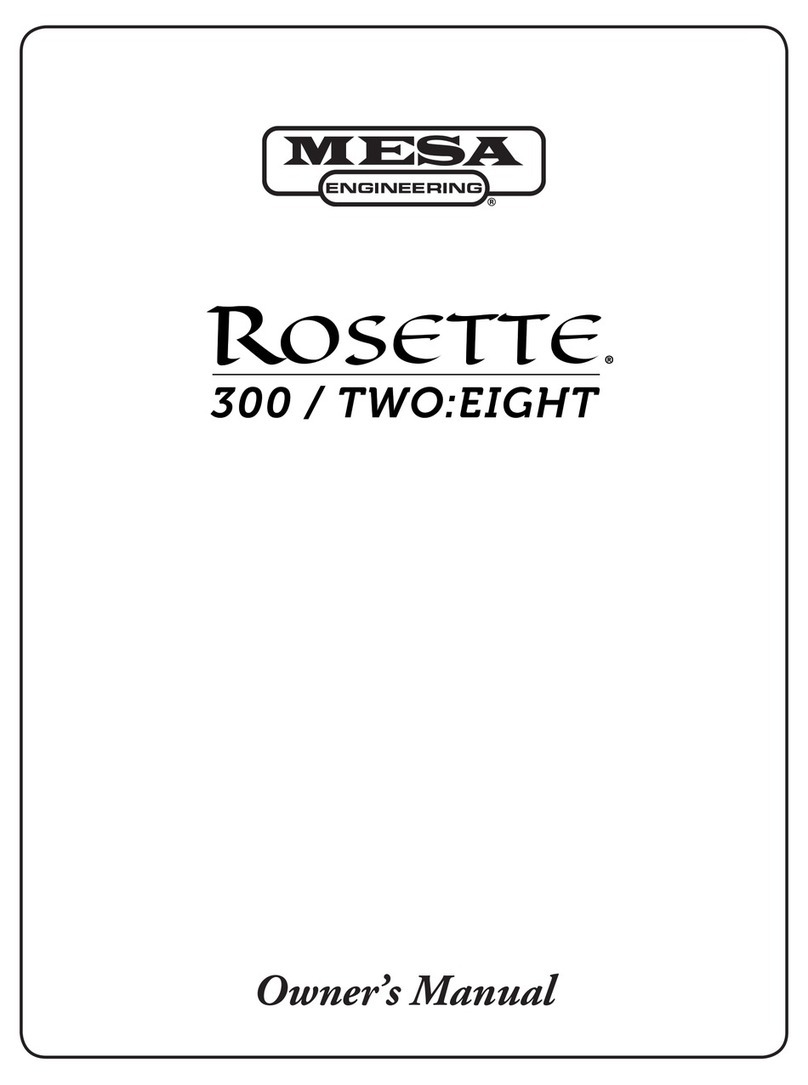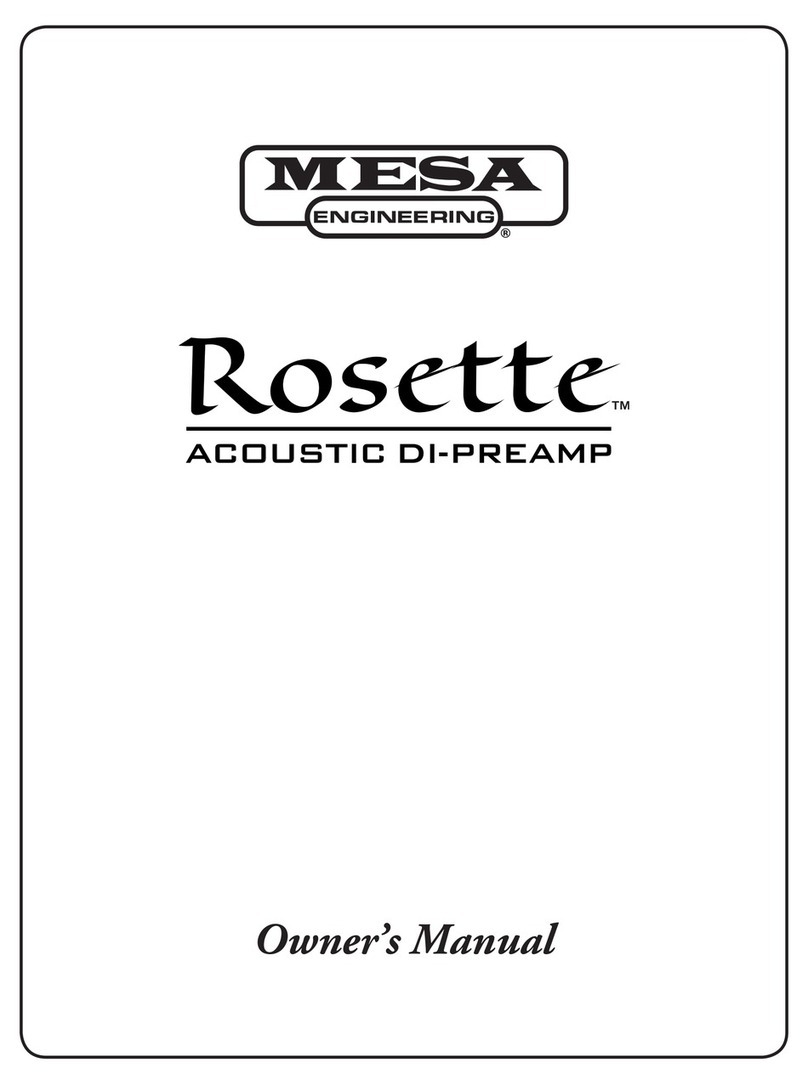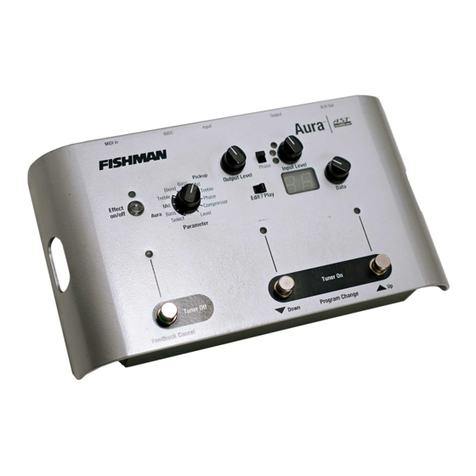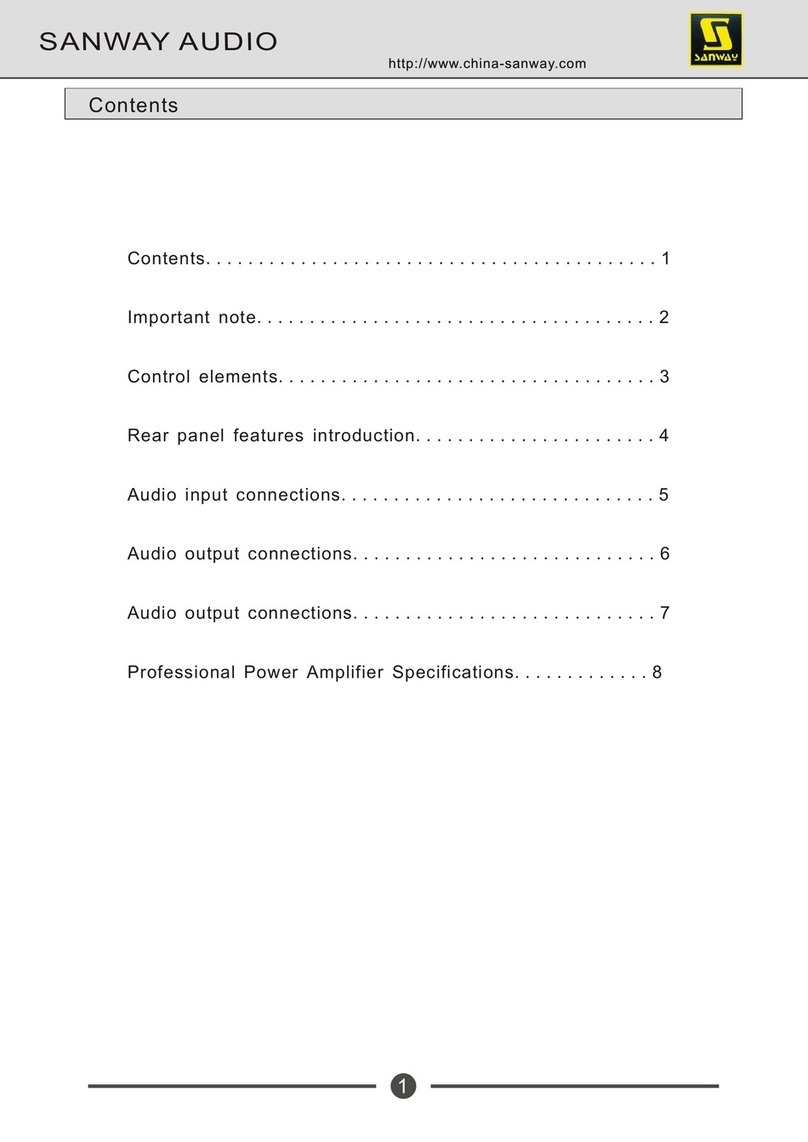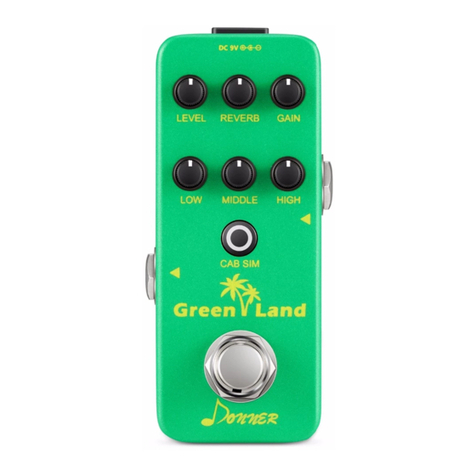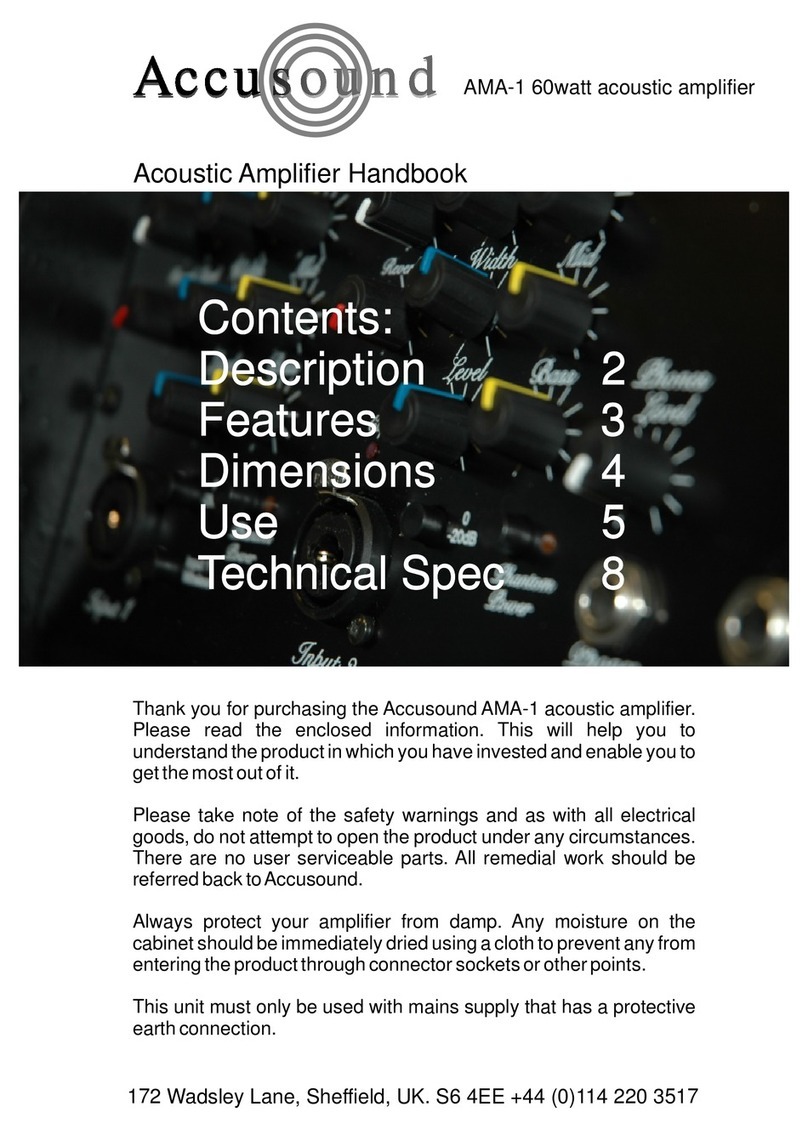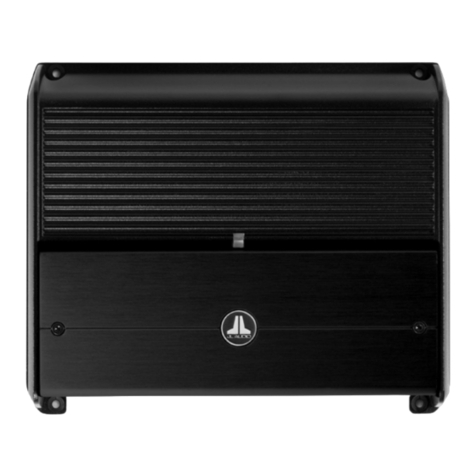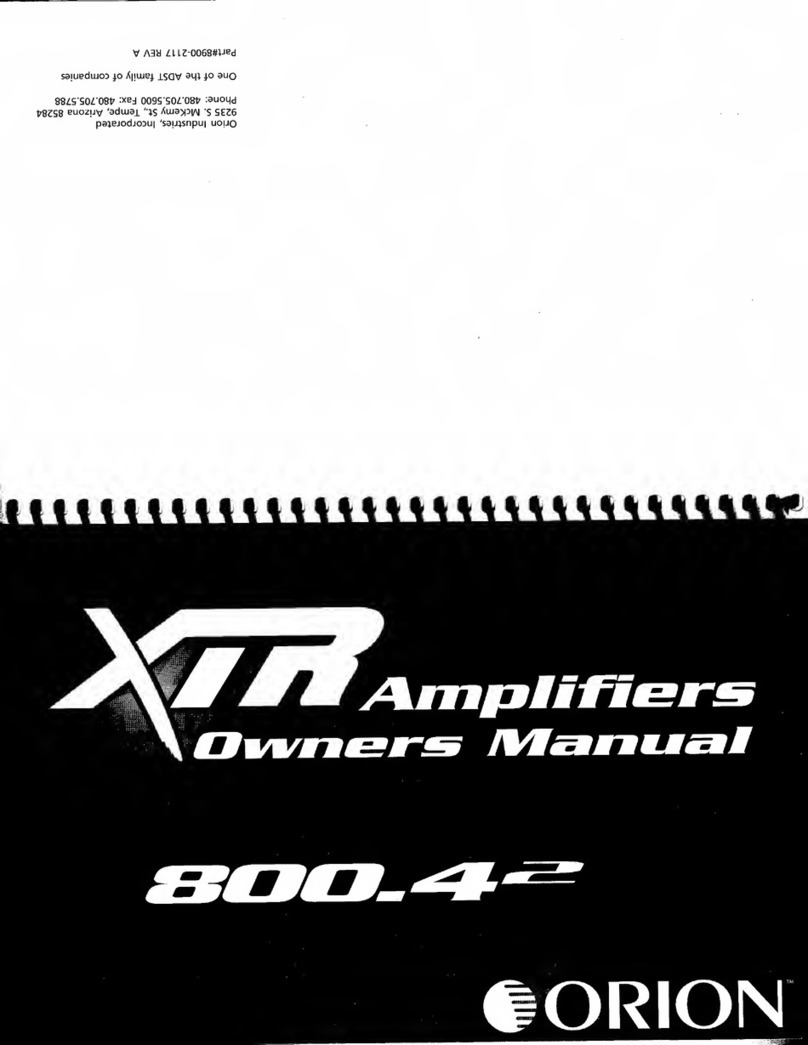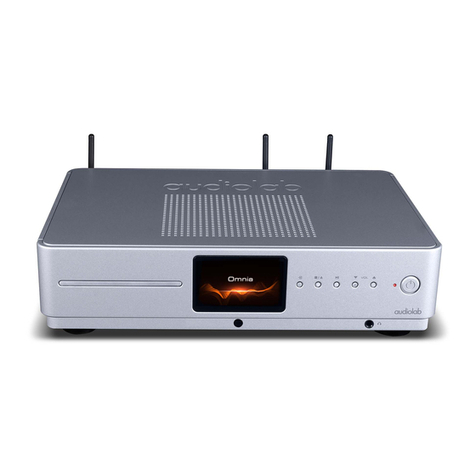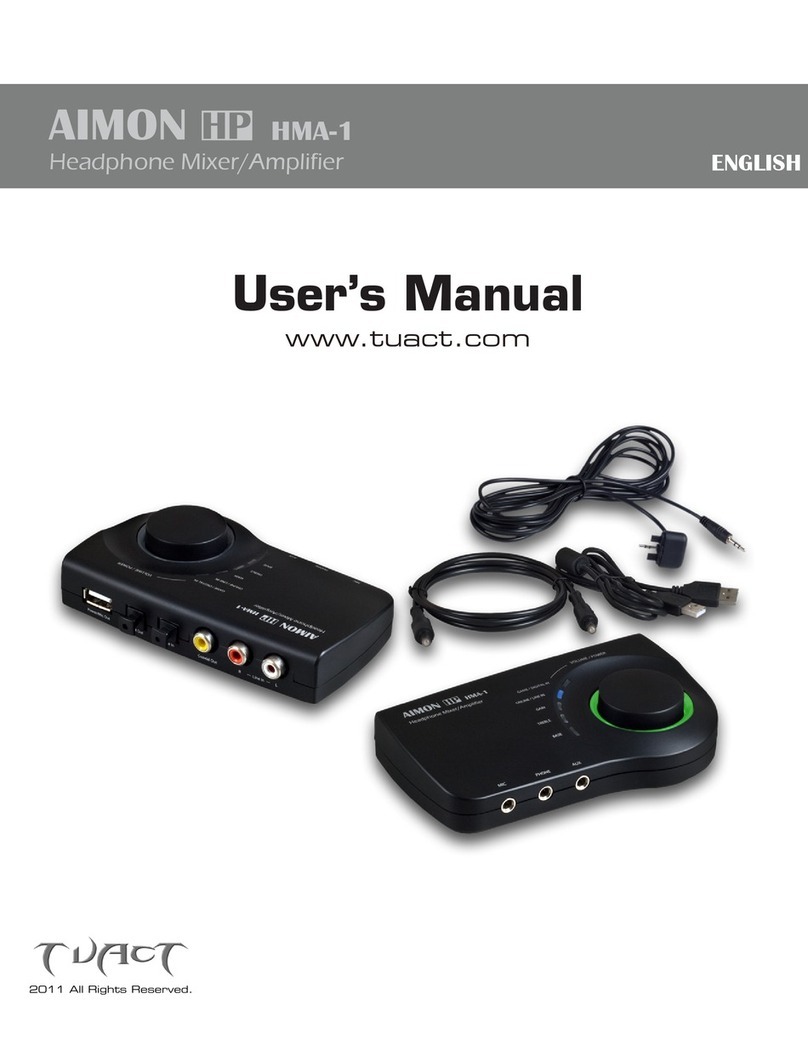Mesa Amp User manual

OOGIE
B
M
ESA
1317 Ross Street Petaluma, CA 94954
USA
The Spirit of Art in Technology
Owner’s Manual

Hello from the Tone Farm...
...You, smart player and all around intuitive human, have put your trust in us to be your
amplifier company. This is something we do not take lightly. Our reward is that we've
made a classic amplifier and by choosing this amplifier, you have become part of the
MESA family...WELCOME! Our goal is to never let you down. Your reward is that you
are now the owner of an archetypal guitar pre-amp, bred of fine all tube amp
heritage...benefiting from the many pioneering and patented MESA circuits that led to the
refinement of your new instrument. Feel confident, as we do, this amp will inspire many
hours of musical satisfaction and lasting enjoyment. It was built with you in mind, by
players who know the value of a fine musical instrument and the commitment it takes to
make great music. The same commitment to quality, value and support we make to
you...our new friend.

Do not expose amplifier to moisture, rain or water,
direct sunlight or extremely high temperaturres.
Always insure that amplifier is properly grounded.
Always unplug AC power cord before changing fuse
or any tubes.
Avoid direct contact with heated tubes.
Insure adequate air circulation behind amplifier.
Keep amplifier away from children.
Besure to connect to an AC power supply that meets
the power supply specifications listed on the rear
panel of the unit.
If there is any danger of lightning occurring nearby,
remove the power plug from the wall socket in ad-
vance.
To avoid damaging your speakers and other play-
back equipment, turn off the power of all related
equipment before making the connections.
Do not use excessive force in handling control but-
tons, switches and controls.
Remove the power plug from the AC mains socket if
the unit is to be stored for an extended period of
time.
USE COMMON SENSE AND ALWAYS OBSERVE THESE PRECAUTIONS:
Your MESA/Boogie Amplifer is a professional instrument. Please treat it with respect and operate it properly.
YOUR AMPLIFIER IS LOUD! EXPOSURE TO HIGH SOUND VOLUMES MAY CAUSE
PERMANENT HEARING DAMAGE!
No user serviceable parts inside. Refer service to qualified personnel. Always unplug
AC POWER BEFORE REMOVING CHASSIS.
EXPORT MODELS: Always insure that the unit is wired for the proper voltage.
Make certain grounding conforms with local standards.
READ AND FOLLOW ALL INSTRUCTIONS OF PROPER USAGE.

TABLE OF CONTENTS
REAR PANEL
PHANTOM POWER
MIDI CONNECTIONS: IN / THRU / OUT
A.C. POWER : GROUND / LIFT
EXTERNAL SWITCH JACKS and RECORD OUT
MAIN OUT
FX LOOP
THE CONTROLS: PARAMETERS
THE MODES: DESCRIPTION / USES
VERSION 2.0: CONTINUOUS CONTROL SOFTWARE
TUBE TASKS / PLACEMENT / DIMENSIONS / SPECIFICATIONS
WIRING DIAGRAMS
FACTORY PRESET LIST & SETTINGS 1 thru 10SAMPLE SETS
PERSONAL SETTINGS PAGES
PARTS SHEET & PANEL IDENTIFICATION PAGE
8 - 11
12 - 20
21 - 26
27
OPERATIONS
36 - 37
28 - 35
FRONT PANEL
EDITING: PRESETS / PROGRAMS / PARAMETERS
TO COPY and MODE SELECTION
MAPPING: PRESET / PROGRAM
PROGRAM / CHANNEL WINDOW
CHANGING MIDI CHANNEL
DATA DUMP
DEFEAT FACTORY PRESETS / RECALL FACTORY PRESETS
4 - 5
5
PAGE
1 - 2
3
4
2
3
6
1
7
6
6
7
38 - 39
40

TURN POWER ON AT REAR OF UNIT:
ON/LIFT
OFF
ON GROUND
RUN THROUGH FACTORY PRESETS 1-10
PROGRAM/CHANNELPRESET
PGM
/CH
EXIT
ENTR
COPY
0
PRESET
NUMBER
OUTPUT
RHY
LD1
LD2
SW 1 2 3 4
FX LOOP
DYNAMIC VOICE
PRESENCEMASTERLEAD 2 DRIVELEAD 1 DRIVE
BASSMIDDLETREBLEGAIN
PROGRAM/CHANNEL
PRESET
PGM
/CH
EXIT
0
123456789
5
6
7
8
9
10
4
3
2
1
0
A B
ENTR
ALL TUBE PREAMPLIFIER
OOGIE
B
M
ESA
TO INCREASE OR DECREASE
TO ENTER AND SAVE NEW PARAMETER SETTINGS
COPY
PRESET
EXIT
ENTR
PROGRAM/ CH
4
FLASHES
TO ACTIVATE PROGRAMMABLE FX LOOP AND FUNCTION SWITCHES:
OUTPUT
RHY
LD1
LD2
567
8
9
10
4
3
2
1
0
A B
LOOP
SW
SW 1 2 3 4
FX LOOP
ALL TUBE PREAMPLIFIER
OOGIE
B
M
ESA
PAGE1
NOTE: The AC Power Switch is a 3 position - center off type switch. Always try the
ON/GROUND position first (switch down). If hum is noticed in the sound, then try the ON/LIFT
position. Whenever possible it is best to use the grounded position for many reasons unless having
TriAxis grounded creates noise problems such as buzz or AC hum.
NOTE: The A.C. power for TriAxis should be derived from the same power strip as that of the power
amp in use. Any effects units used should also be plugged into this same strip. This close proximity
of A.C. power supply for units within a system will prevent TONE degradation. Failure to follow this
wiring scheme may result in harsh or excessively bright tonal characteristics.
To do so use the Preset keys. (Notice that 11-20 do not sound
very different unless TriAxis Switch 1 Jack is connected to a Mesa Switch
Track power amp and Track Switching is used.)
NOTE : Factory presets 1 thru 20 are Loaded automatically during power-
up, but can be disabled or reloaded manually by user when defeat proce-
dure is followed...see page 4 for directions.
Presets, Programs or Parameters use any of the arrowed keys.
to an existing preset, press the
ENTR
key two times. If pressed
one time Preset flashes to indicate it will be overwritten when you press
ENTR
key a second
time. If you happen to change your mind or wish to hear the original preset, press the
EXIT
key while PRESET is flashing to return to the original settings and void any changes you
had made.
Press the
LOOP
SW
key. This allows you to
sequence through all the possible LOOP/SWITCH combinations.
Press the
ENTR
key two times when the desired combination has
been selected to store this combination.

FRONT PANEL:
(Continued)
TO ACCESS PROGRAMS (via the numeric keys)
TREBLEGAINPROGRAM/CHANNELPRESET
PGM
/CH
COPY
01 23
ENTR
FLASH
SHIFT
OOGIE
B
M
ESA
ALL TUBE PREAMPLIFIER
TO ACCESS PRESETS (via the numeric keys)
TREBLEGAINPROGRAM/CHANNELPRESET
PGM
/CH
COPY
01 23
ENTR
FLASH
MAPPING A PRESET TO A PROGRAM
TREBLEGAINPROGRAM/CHANNELPRESET
PGM
/CH
EXIT
COPY
01 23
PRESET
NUMBER PROGRAM
NUMBER
ENTR
PAGE 2
1. Press the
SHIFT
key one time to access the programs.
2. Select PROGRAM using nu-
meric keys located below GAIN,
TREBLE, MIDDLE, BASS, and
LEAD DRIVE windows.
3. Press the
ENTR
key one time to
access new PROGRAM number
and audition the PRESET listed at
that location.
1. Press the
SHIFT
key two times to make PRESET the active window, then
select the new PRESET using the nu-
meric keys once again.
2. Press the
ENTR
key one time to listen
to the displayed flashing PRESET.
3. Press the
ENTR
key two times to write
displayed flashing PRESET to displayed
PROGRAM number.
First understand that PRESETS are “SOUNDS” and that PROGRAMS are “Midi
PROGRAM LOCATIONS.”
1. Call up the PROGRAM LOCATION number that you
wish to write using the keys directly under the PRO-
GRAM / CHANNEL window, a Midi Controller, or by using
the numeric keys located directly under the GAIN thru LEAD
1 DRIVE keys.
2. Choose the desired PRESET “sound” you wish to list under the Program Location number using keys directly under the
PRESETwindow. Now you should see the PRESET you wish to map in the PRESETwindow and the Program Number you wish to
write this PRESET under, in the PROGRAM / CHANNEL window.
3. Press the
ENTR
key two times. Procedure is now complete.
SHIFT
OOGIE
B
MESA
ALL TUBE PREAMPLIFIER

PAGE 3
FRONT PANEL:
(Continued)
COPY FEATURE
TREBLEGAINPROGRAM/CHANNELPRESET
EXIT
ENTR
COPY
01 23
FLASH
PGM
/CH
SHIFT
OOGIE
B
M
ESA
ALL TUBE PREAMPLIFIER
MODE SELECTION
OUTPUT
1 2 3 4
FX LOOP
567
8
9
10
4
3
2
1
0
A B
MODE
RHY
LD1
LD2
SW
ALL TUBE PREAMPLIFIER
OOGIE
B
M
ESA
DYNAMIC VOICE
PROGRAM / CHANNEL WINDOW
PGM
/CH
PROGRAM/CHANNELPRESET
COPY
CHANNEL
NUMBER
To copy one PRESET to another PRESET location: 1. Choose the PRESET you wish to copy.
2. Press
SHIFT
key and then press
ENTR
key. This “Source” PRESET now
flashes four times.
3. Select the “Destination” PRESET
using numeric keys located below the
GAIN thru LEAD 1 DRIVE windows.
You will now see the Destination PRE-
SET in the PRESET window.
4. Press
ENTR
key one time. The Destination PRESET now flashes indicating that the contents of the Destination PRESET will be
replaced by the “Source” PRESET parameters. (If you want to stop this copy procedure and avoid overwriting the Destination
PRESET, press the EXIT key and return to the “Source” PRESET.)
5. To complete the copy procedure, press the
ENTR
copy key one more time. The “Source” PRESET is now copied to the Destina-
tion PRESET and the PRESET display returns immediately to the “Source” PRESET. If you wish to check your work, toggle back
to the destination PRESET and confirm the parameter values were copied.
To sequence through the 8 modes, press the
MODE
key each time to select a new mode.
NOTE: Keep in mind the settings do not change with the
MODE
key, so if something sounds strange or if no sound is
heard, check Mode/Parameter settings.
THE MODES ARE SHAPED AS FOLLOWS:
Rhy-Green=Vintage Fat Rhythm Lead 1 - Red = Dual Rectifier Vintage Channel
Rhy-Yellow=Modern Bright Rhy Lead 2 - Green = Mid Gain MK IV Lead
Lead 1-Green=Vintage Mark 1 Lead Lead 2 - Yellow = Classic MKII Lead (MK II-V)
Lead 1-Yellow=Gain Boost MK I Ld. Lead 2 - Red = Searing MKIII Lead
(For greater detail on individual modes, see the modes section in this manual)
Feedback to the user regarding current Midi Program Number or current Midi Channel is
displayed in this window.
NOTE: Remember User PRESETS are not to be confused with Midi Programs. Pre-
sets are created by you (or at the factory) and can then be assigned to a Midi Program
number. In other words; Presets are sounds and Programs are Locations.

FRONT PANEL:
(Continued)
PROGRAM / CHANNEL WINDOW: (Continued)
TO CHANGE MIDI CHANNEL NUMBER
COPY
PRESET PROGRAM/CHANNEL
PGM
/CH
EXIT
ENTR CURRENT
MIDINO.
MIDI SYSTEM EXCLUSIVE DATA DUMP FEATURE
PROGRAM/CHANNELPRESET
COPY
4
FLASHES
EXIT
ENTR
PGM
/CH
IN
OFF
ON/LIFT
ON GROUND
MIDI
THRU OUT
SHIFT
ALL TUBE PREAMPLIFIER
OOGIE
B
M
ESA
PAGE 4
TRANSMIT DATA DUMP RECEIVE:
NOTE: From Power-up, the Midi Program number last used appears in
the PROGRAM / CHANNEL window. To view the current Midi Channel
that TriAxis is set to receive Program Change commands on...Press the
PGM
/CH
key below this window.The display changes to the
current Midi Channel and the channel number flashes. Press the
PGM
/CH
key to retrurn to the current Midi Program number.
REMINDER...The Midi Channel will not be displayed uinless you push the
PGM
/CH
button.
Press the
PGM
/CH
key. The PROGRAM display now indicates current Midi Channel
number by flashing.
Use the keys to change the CHANNEL number. When the desired chan-
nel is reached, press the
PGM
/CH
key to return the display to the PROGRAM number.
All of the information stored in memory, including PRESET/PROGRAM
combinations and LOOP/SWITCH settings, may be dumped to an external storage medium such as an “Alesis Data Disk”, personal
computer or any other system with a Midi port and hard or floppy disk storage capabilities. These settings (information) can then be
retrieved and loaded back into memory from the storage medium, providing backup and/or limitless expansion of the TriAxis memory.
NOTE: The manufacture’s system exclusive identification code number for the TriAxis is 00004A. In case you ever need to list your
files on a personal computer, this would be a possible title. However, the majority of owners will probably never need this number.
1. Connect a 5-Pin DIN cable from the TriAxis Midi Out Jack. Follow instructions as
to how to set the storage medium’s Midi IN port to the receive ready state.
2. Press the
SHIFT
key and then the PRESET down key
(arrowed key facing to the left) on the TriAxis. You will now
see the PRESET window display flash four times, indicating
the “Dump” has been completed.
NOTE: You may possibly see the I.D. number appear on the screen of the
destination unit and then something like “Dump Completed.” The whole pro-
cedure takes about 500 milliseconds and all the information in the TriAxis
memory is still intact. At this time you may write new presets knowing that all
of your previous presets are safely backed up.

FRONT PANEL:
(Continued)
RECEIVE
(Loading)
PROGRAM/CHANNELPRESET
COPY
4
FLASHES
GAIN
OFF
IN
ON/LIFT
ON GROUND
MIDI IN JACK
REAR PANEL
DEFEAT /RECALL OF FACTORY PRESETS 01 -20
OUTPUT
RHY
LD1
LD2
SW 1 2 3 4
FX LOOP
567
8
9
10
4
3
2
1
0
A B
LOOP
SW
SHIFT
OOGIE
B
M
ESA
ALL TUBE PREAMPLIFIER
OUTPUT
RHY
LD1
LD2
SW 1 2 3 4
FX LOOP A B
MODESHIFT
ALL TUBE PREAMPLIFIER
OOGIE
B
MESA
567
8
9
10
4
3
2
1
0
PAGE 5
To load all of your previously written sounds and information into the TriAxis, the procedure is very
simple!
1. Connect storage medium’s Midi Out jack to the TriAxis Midi IN jack.
2. Make sure storage medium is set to transmit the correct information (file)
3. Make sure the PRESETS currently in TriAxis are “Backed Up”, as the load
you are preparing to do will erase all existing information in the TriAxis memory.
4. Key in Transmit or Send on the storage medium. The previously stored
info will be loaded into TriAxis. The PRESET display window will flash four
times confirming that the transmission has been received.
If you run out of Preset Memory using Presets 21 - 90 or you simply
prefer to start writing your sounds at Preset 01, the first 20 factory
presets may be overwritten and yet recalled for future comparison.
1. DEFEAT: Press the
SHIFT
key once, then the
LOOP
SW
key. This defeats the
factory preset power load-up command and makes it possible to write mode
and parameter settings of your choice into PRESET locations 01 through 20.
Remember the factory PRESETS will stay in these locations until you follow
this procedure to defeat them.
2. RECALL: To recall the factory PRESETS in their entirety, press the
SHIFT
key once, then press the
MODE
Key. Bear in mind this command wipes out all
previously stored information in PRESETS 1 - 20, so be sure you have BACKED
UP your memory if these are important PRESETS in these PROGRAM / LO-
CATIONS.

REAR PANEL
PHANTOM POWER
OFF
IN MIDI
THRU OUT
ON/LIFT
ON GROUND
MIDI IN, THRU AND OUT JACKS
MIDI
THRU OUT
OFF
IN
ON/LIFT
ON GROUND
SWITCH
OFF
IN MIDI
THRU OUT
ON/LIFT
ON GROUND
1
2
SWITCH
4
3
RECORD
1
2
SWITCH
4
3RECORD
PAGE 6
The coax power jack above the A.C. line cord can provide power to a Midi foot controller, through the 7
pinMidi IN jack. This is accomplished by connecting an external A.C. to
D.C. power adapter of correct voltage and polarity for whatever type of
foot controller you are using to the coax jack on the rear panel of TriAxis.
The Mesa/Boogie Abucus foot controller requires the following power
requirements: 12 Volts @ 500 ma, Tip = Ground and Sleeve = Positive.
Connect a 7-pin DIN cable between the Midi In jack on the TriAxis and the
Midi Out jack on the foot controller. This negates the need for a clumsy power adaptor on the stage.
NOTE: 7 -Pin DIN cable will not fit into 5-Pin DIN jacks. Check to see that your foot controller accepts 7-Pin DIN cables and is wired
to accept Power in this manner...and of the proper voltage match to TriAxis’ phantom power output.
TriAxis provides the standard “Midi Interface” via these three jacks. Connect the 7-Pin
DIN to the Abacus or similar foot contoller. Then connect the next device’s Midi In jack to TriAxis Midi THRU jack.
TriAxis’s Midi “THRU” and Midi OUT jacks mirror all incoming Midi mes-
sages. The “THRU” jack will not send Data Dump or other similar com-
mand information. Use the Midi “OUT” for all such commands. The “OUT”
also sends Midi program change messages when the Program keys are
used on TriAxis’ Front Panel.
Switch Jacks 1 through 4 provide “Tip to Ground” function switches for controlling or activating external devices such
as the “Switch-Track” voicing features that are incorporated into Mesa/Boogie Switch Track power amplifiers. They will also control
many, but not all, Bypass, Hold, Mute etc. func-
tion jacks found on many Non-Mesa products
that do not use momentary logic. If they do not
control a device that you own, we suggest call-
ing that devices manufacture for specific volt-
age requirements, as TriAxis may not provide
“ground” needed to control the particular device.
These jacks provide direct stereo interfacing to recording or live mixing consoles. They faithfully reproduce both lead
and rhythm sounds similar to those you are accustomed to hearing from your power amp
and speakers. The output level is determined by the front panel programmable MASTER
control setting. At extreme settings it may be possible to overload the console’s input
circuit. Medium Master control settings are probably sufficient for most situations. Check
your levels.

REAR PANEL:
(Continued)
OUTPUT
OFF
ON/LIFT
ON GROUND
1
2
SWITCH
4
3RECORD OUTPUT
A
B
IN MIDI
THRU OUT
OFF
IN MIDI
THRU OUT
ON/LIFT
ON GROUND
1
2
SWITCH
4
3RECORD OUTPUT RETURN SEND
FX LOOP
A
B
FX LOOP
ENTER
RHY
LD1
LD2
SW
DYNAMIC VOICE
PRESENCE
MASTER
LEAD 2 DRIVELEAD 1 DRIVE
BASSMIDDLETREBLEGAIN
PROGRAM/CHANNEL
PRESET
PGM
/CH
0
12
34
56
789
OUTPUT
567
8
9
10
4
3
2
1
0
A B
LOOP / SWITCH
FX LOOP
1234
LOOP
SW
ALL TUBE PREAMPLIFIER
OOGIE
B
M
ESA
ENTR
PROGRAMMABLE MASTER VOLUME:
Also acts as an FX Send Level Control.
INSTRUMENT INPUT
PAGE 7
FX LOOP
SEND
4
3
1
2
SWITCH RECORD OUTPUT RETURN
B
A
OFF
IN MIDI
THRU OUT
ON/LIFT
ON GROUND
INST
INPUT
These A/B jacks provide two outputs, left and right, for interfacing to power amplifiers or directly to your effects units.
These jacks provide a Mono send and Stereo return effects loop configuration. The LOOP is programmable via
the LOOP/SWITCH and ENTER keys located on the Font Panel (see illustration below) and its’ status determined per PRESET. The
Front Panel programmable MASTER control determines the FX SEND LEVEL.
Press the
LOOP
SW
Key to toggle between the desired combination of FX LOOP and Function Switches on a given PRESET/PROGRAM
combination. To write this combination, Press the
ENTR
key two times. This LOOP/SWITCH combination is now stored under the
displayed PRESET PROGRAM.
The instrument jack is located to the far right on the Rear Panel.

DYNAMIC VOICE
PRESENCEMASTERLEAD 2 DRIVE
GAIN TREBLE MIDDLE BASS LEAD 1 DRIVE
4
0123 567 89
THE CONTROLS
GAIN
0
1
TREBLE
23
MIDDLE
45
PAGE 8
This is by far the most critical and powerful of the controls in TriAxis. It not only determines the overall gain amount,
shape and sensitivity of each mode...but it is sort of a Tone control as well. Generally speaking, whatever is dialed
here ultimately determines the mode’s personality. Set low, it allows “cleaner” brighter sounds with enhanced
dynamic response, especially in the higher frequencies. Set high the whole personality of the mode becomes
fatter and more overdriven. In TriAxis we worked hard to make sure the entire range of the Gain is usable and
more importantly, musical. Don’t think for a moment that this simple layout limits you as to the amount and texture
of gain. Long neurotic hours were spent to ensure the frequencies, as well as the ranges, of gain available here
were stylistically accurate. It’s probably good to mention here that most of the great sounds can be found by
setting the GAIN control moderately, especially in the 6 Lead modes. For example, somewhere between
2.0
and
8.0
in the Lead modes, and between
3.0
and
8.0
in the Rhythm modes. This reduces the likelihood of pesky tube micro-
phonic problems occuring while at the same time making the modes easier to balance with each other in regards to volume and
effects send level strength.
As with most all tube guitar amplifier, the TREBLE control is the strongest of the three tone controls. Its’ setting in
the TriAxis determines the blend and strength of the MIDDLE and BASS controls. Set high, it is the dominant
control, minimizing the amount of MID and BASS possible in the mix. Set low the TREBLE becomes the recessive
control and a warmer, darker blend is produced. Dial with care. Subtle tweaking of this control tends to produce the
best results.
The MID control determines midrange punch and boldness in lower gain sounds and a smooth “vocal” blend in high
gain sounds. It can be very effective in acting as a “cut through the band control” in certain situations. Dial to taste,
remembering that the setting of the TREBLE control greatly effects its’ strength. However...there is an
exception...in the LEAD 1 Red mode the MID control is extremely powerful. Its action may be likened to that of
the TREBLE control in all the other modes. The MID can completely re-shape the entire personality of this pre-tone
gain mode simply by setting it either very low or very high. This difference is because in the other 7 modes, a
standard MID value pot and circuit placement scheme is in place. When the Lead1 Red mode is selected, the MID
control changes drastically and its placement in the circuit is moved.
Setting the MID very low in this mode scoops all the attack and lends a spongy liquid character to the sound. This type of setting works
very well for single note work or very low gain rhythm playing. The strings will seem easier to play if the Mids are kept low in the Lead
1 Red mode. Setting the MID control high in Lead 1 Red adds extreme attack and aggression. In this range of settings, the GAIN and
LEAD DRIVE controls can be set relatively high before any mush or lack of articulation is noticed. This type of MID setting also helps

PAGE 9
THE CONTROLS (continued)
LEAD 1 DRIVE
89
LEAD 2 DRIVE
the bottom end stay tight - even at rather high BASS control settings. Harmonic “chirping” and “held” note “harmonic
leaping” are easier to obtain with higher settings of the MID control. In short, the MID control acts as the dominant
tone shaping control in the LEAD 1 Red mode.
This control blends in the lower frequencies and its’ effectiveness, again, depends on the setting of the TREBLE
control. It should be set with moderation as extreme settings in either low or high directions can produce an unbal-
anced tone. Be especially careful in higher gain settings of all modes except Lead 1 Red. Too much Bass will cause
a flabby, unfocused sound that can’t be dialed out elsewhere because excessive Bass has been introduced early on
in the circuit. Try setting the BASS control to
4.0
or
5.0
for clean sounds in the Rhythm modes and
3.0
or below
when dialing up high gain overdrive sounds in these nodes. In the Lead modes, try setting the BASS somewhere
between
3.0
and
6.0
depending on the amount of Gain and Treble that’s dialed up. Keep in mind that Lead 1 Red
has its’ own dedicated range of the BASS control,
5.5
to
10
, as it can support higher BASS control settings than
the other 7 modes. See explanation in the Modes section of this manual under “Lead 1 Red.”
This is the principal gain control for the Lead 1 group of circuits. It determines the amount of overdrive present at the
most crucial pre-amp tube stage in these three lead modes. As we mentioned earlier in the Mode section of this
manual (see Lead 1 Red), this controls’ location moves along with many other parts to better accommodate this pre
- tone control type of architecture. In the Green and Yellow modes, LEAD 1 DRIVE affects the first tube stage of
significance and high settings of the LEAD 1 DRIVE here, will produce rich warm gain that “fills in the holes” and
blends the harmonics subtly. We feel the best sounds are achieved by matching the LEAD 1 DRIVE to the
setting of the GAIN control (far left-front panel) or setting the LEAD 1 DRIVE slightly below that of the GAIN...for
example, GAIN at
8.0
, Drive at
8.0
or GAIN at
8.0
DRIVE set at
6.0
etc. This scheme lends itself to the most
focused, well balanced sound.
In the Red mode, the LEAD 1 DRIVE makes its’ move down the line to a later stage, where it can be more effective. At this point it is
wise to mention once again that the GAIN control is a crucial part in the operation of Lead 1 Red. As we said earlier (see Modes
section, Lead 1 Red) this location is usually a discreet resistor in pre-tone circuits, while in TriAxis, it is an adjustable pot. It is
therefore important for you to set this GAIN control to the proper “fixed” resistance...at least to check it out before deciding to deviate
from the recommended setting. Set the GAIN control at
6.0
, if you find this lacking (gain wise), increase the LEAD 1 DRIVE before
increasing the Gain. This will ensure tight bottom end response while producing a less buzzy quality in higher frequencies.
Once again, the Lead 2 group of modes are post tone control. Therefore, the fine tuning of overdrive must occur
later in the circuit where it can focus on finer increments of gain. This Drive control meters the Gain in the third stage
of the Lead 2 group of circuits. Its’ taper was chosen to deliver very fine increments of gain in the lower regions,
0.0
through
3.5
...small increments in the middle range of
4.0
through
7.5
and fairly substantial increments in the
upper range
8.0
through
10
. As with many of the controls aboard TriAxis, moderation often produces the best
results. Try using this control subtly in conjunction with the GAIN control. It is usually unnecessary to set the Lead 2
DRIVE above
8.0
, even for the most crazy rock sounds. If you are finding moderation to tame when using this
control...perhaps it is time to take a look at other parts of your system, ie. your guitars’ pick-ups, speakers, power
amps etc. In other words...there should be more than enough gain here to accommodate even the most extreme
styles.
MIDDLE
45
67
BASS

THE CONTROLS (continued)
MASTER
PRESENCE
PAGE 9
Once again the two controls, GAIN and LEAD 2 DRIVE, work in tandem with each other and their mix is crucial to
finding a specific sound. In general, the higher the Gain...the darker, fatter and more saturated the sound will be.
The higher the LEAD 2 DRIVE...the brighter, more harmonic and aggressive the character becomes. We like to see
a GAIN control setting of
7.0
or
7.5
for bluesy or medium gain solo sounds and
8.0
for the more high wire rock
sounds. Then simply adjust the LEAD 2 DRIVE to taste. Many of the coolest sounds find the LEAD 2 DRIVE either
equal to, or substantially lower than these afformentioned Gain settings. Specifically check the lower range of the
LEAD 2 DRIVE where the threshold of distortion is incredibly smooth and single notes purr. Consult the factory
presets for comparison purposes and as always...experiment.
The programmable MASTER control serves three purposes in the layout of the TriAxis. FIRST: It serves as a
level balancing control for each of the eight modes. This enables a wide range of front end GAIN control settings
to be matched to a given listening level and the relative level compared to the other modes. SECOND: It acts as
an effects send control for each mode in the Effects Loop. As with many of the controls in TriAxis, the best
results for balance and tone are usually found in the middle range of this control. THIRD: The MASTER is the
Recording jacks’ send level control. When using the direct Recording jacks found on the Rear Panel to interface
directly to a mixing board or a recorder, this control will determine the amount of signal you will be sending via these
jacks. In this application it is usually best to start with the MASTER control set to
0.0
and gradually increase it to the
desired level. This minimizes the possibility of blowing speakers or eardrums in the event the engineer has an
extremely sensitive input headroom setting in place at the console. Once again avoid setting the programmable MASTER above
6.0
in the Clean Rhythm modes (Green/Yellow) as high settings here can possibly overload the input stage of the DYNAMIC
VOICE control, producing unwanted clipping.
This control usually regulates either brightness or negative feedback in the power section of an amplifier. In the
TriAxis a whole new approach to this traditional circuit was taken. An actual dynamic feedback loop that com-
presses the highs and upper treble frequencies makes this PRESENCE control the first of its’ kind. In applying for
the patent for this unique (high compression) circuit, we discovered that this same basic concept can apply to many
parts of the tube amp in guitar amplification and your TriAxis is the first benefactor of such a breakthrough. With
greater understanding and patent grants behind us, lets talk sound.
As the PRESENCE control is increased, more highs are allowed to pass. The lower the signal strength at the input
of this control, the more highs pass through it. The lower region of the PRESENCE control dampens these high
harmonics. The greater the signal strength at the circuit input becomes, the darker the sound becomes. So...if you set the PRES-
ENCE control high and pick softly (sending a small signal through the PRESENCE control circuit) the highs will be very promi-
nent in the mix. If you decrease the PRESENCE control and pick harder (increasing the signal strength at the PRESENCE
control circuit input) the high harmonics will be very subtle. In other words, the PRESENCE control helps enhance whichever
direction your’re trying to go in with your sound and it does so dynamically! Most players love the way tube circuits react to subtle
nuances in style...This PRESENCE control circuit takes that idea a few steps further. When you’re “going off” on the treble strings in
a solo and you go for an expressive bend and lay hard into the note...TriAxis works with you! If you picked the note hard with the
PRESENCE control set low, that note would become bigger, rounder and more compressed.
Likewise, if you were doing some low growling work on the bass strings and the PRESENCE control was set high...you could relax
into this segment and let the PRESENCE control make the edge. Most everyone that we know always wishes their high notes could
be fatter and their low notes to be more discernable and articulate...highs where you need them, lack of highs where you don’t. Make
sense...? If not on paper, then you need to plug in and experience the way this dynamic PRESENCE control can enhance your
playing, especially when you are soloing.
LEAD 2 DRIVE

PAGE 10
THE CONTROLS (continued)
DYNAMIC VOICE
This innovative circuit enabled the TriAxis’ one space package to include all the power and sonic character of the
5 band graphic equalizer found aboard most Boogie combos and heads. Obviously there was no room to house
the five sliders necessary to make this E.Q. circuit a graphic type...yet we were determined to find a way of fitting
this valuable sound shaping tool into TriAxis. A creative approach led to a way of using an increment and
decrement key to control all five bands at once! Better yet, the TriAxis’ method actually blends the equalized
signal with the “dry” signal. So, unlike our traditional Graphic equalizer - where the whole signal passes through
the circuit once it is activated...the DYNAMIC VOICE circuit is an EQ and built in mixer all in one! As the DY-
NAMIC VOICE is increased, the “dry/wet” mix is increased proportionally. This set up lends some extremely cool
and subtle sounds that can be obtained at the lower range of the control
1.0
through
4.0
. As the control is
dialed through its middle and upper ranges, the mix becomes more predominantly e.q.’d and at a DYNAMIC VOICE setting of
10
the whole signal is passed through this circuit.
Simultaneous to this mixing action, the EQ “curve” changes proportionally. The DYNAMIC VOICE uses a preset curve that was
chosen from countless hours of R&D and referencing hundreds of Boogie owners’ favorite “curve”. However, this curve changes
depending on the setting of the control. At
0.0
the mix is at 0% and the curve is flat. At
10
the mix is at 100% and the low end is
boosted, the midrange is cut and the highs are accentuated to promote that harmonic blend that’s so crucial to high gain rock or metal
sounds. Between the settings of
0.0
and
10
, there is a whole range of curves/mixes that can enhance both clean and overdriven
sounds equally. We have found the best settings fall into a couple of setting areas: Clean sounds (though they are usually at their best
without the DYNAMIC VOICE) work well with a setting of
1.0
or
2.0
. Lead sounds seem to support higher settings of
3.0
through
7.0
with the craziest sounds occuring at
6.5
through
7.0
. At settings this high, it will probably be necessary to reduce the
programmable MASTER control in order to balance the volume level with other presets that do not use the DYNAMIC VOICE.
The DYNAMIC VOICE was designed to complement the Lead 2 modes in particular. This circuit is very effective in shaping the post
tone control Lead circuits that make up Lead 2. As mentioned, these modes don’t benefit from high settings of the BASS control,
because large quantities of Bass dialed up early in the pre-amp, produce flubby indistinct attack characteristics. The pre-set curve in
the DYNAMIC VOICE was custom tailored to add just the right frequencies of Bass, blended with specific highs to yield a huge low
end, while retaining a tight focused attack. The Boosting with DYNAMIC VOICE occurs for these 3 modes late in the circuit, where it
is most effective and least detrimental to the tight attack. However, don’t let this dedication prevent you from experimenting with the
DYNAMIC VOICE, as you will find it an enhancement in virtually all of TriAxis’ 8 modes. We just wanted you to understand our
thinking on this - in order to know best where to use the DYNAMIC VOICE and how much to use it, to obtain the best overall results
from this intuitive equalizer circuit.
80 240 750 2200 6600 80 240 750 2200 6600
80 240 750 2200 6600
80 240 750 2200 6600
SETTING
4.5 MIX
40%
0.0
SETTING MIX
0% SETTING
2.0 MIX
20%
SETTING
7.0 MIX
70%

THE CONTROLS (Dynamic Voice continued)
OUTPUT
567
8
9
10
4
3
2
1
0
A B
REST AREA
PAGE 11
NOTE: It is possible, either through a certified phone instructed technician in your area, or by sending your unit directly to us, to re-
shape the existing pre-set curve slightly to fit your needs. This is somewhat of a hassle and is not covered under the warranty.
(However, if you pay shipping both ways, Mesa will do this mod only, free of charge!...for a period of at least one year after your
purchase date.) Before you even think of pursuing a change, let us tell you that 9 out of 10 players who have requested this change
and have it done end up returning the unit to us asking, “Will we please put the DYNAMIC VIOICE back to the stock curve.” In fact,
at the time of this manuals writing - with 3000 TriAxis’ shipped - we are aware of only three players who have a personally requested
curve aboard their unit. Two of them are Bass players and one is an acoustic player that uses his TriAxis for acoustic guitar sound
reinforcement. Hopefully this will tell you that in the three and a half years of R&D time spent on TriAxis, we absorbed it andcame up
with the curve that seemed to cover most all the bases. Trust us! Try it at length and in depth before you change it. You’ll most likely
end up wanting it put back to stock like everyone else who requested a change. You might as well save yourself the hassle and
shipping cost of this “iffy return” investment in tweakdom. This NOTE: is for you sick tone junkies, in that there may be peace of mind
knowing that no, you aren’t stuck with this curve and yes, you can change it with relatively little trauma or “time without TriAxis tone”
whichever describes your feelings - and at very little cost to you. You can sleep now, you tone addict you.
This lonely knob is the TriAxis’ final OUTPUT control or Overall Master. After the relative balance of the eight
modes have been set with the programmable MASTER control, use this control to increase or decrease the
listening volume level. It is also the effects return level control, though for you the player, this is an irrelevant point
to know. It just makes for a more simple set up and one less knob to deal with when interfacing your favorite
effects. Optimum setting depends on the size of the room, the input settings on your power amp and basically how
loud you want to play. We like to see an OUTPUT control level setting of somewhere between
3.0
and
7.0
....but
adjust to taste.

PAGE 12
THE MODES
RHYTHM:
RHYTHM GREEN:
The architecture of TriAxis, though vast, is quite simple. Its’ eight pre-amp circuits, or modes as we refer to them, are laid out in three
distinct groups. These are Rhythm, Lead 1 and Lead 2. Each of these groups consists of pre-amp circuits that share similar circuit
architecture, parts, and pre-amp tube stages.However, each mode has unique and specific “bones” that define its’ character, person-
ality, and all tube heritage. We grouped them together for many reasons, not the least of which is ease of recognition and familiarity.
Upon hearing the TriAxis for the first time, the majority of players seem to immediatly gravitate toward and identify with, one of the
Rhythm modes and one group of Lead modes. Usually this preference is directly related to what type of amps a player came up
playing. Players who have been Boogie conscious for years and worked their way through the various Mark l, ll, lll, and lV eras,
find both Rhythm modes familiar, but tend to fall in love with Lead 2 Green and Yellow. There is a reason for this attraction, and we
hope by reading this manual and experiencing the TriAxis yourself, you will come to understand these circuit differences and use
them to your advantage - as they not only affect sound, but can actually affect your playing style.
All too aware of the effect amplifier styles have on players and playing styles, we endowed TriAxis from its’ infancy with circuits that
now redefine all the history-making classics with their authenticity. This allows players of all styles to find a home base or comfort zone
right away, especially during the transition period from a conventional amplfier with knobs to the world of midi commands and pro-
grammable memory. It also helps facilitate learning the software and programming. Aplayer can stick with his favorite modes and start
applying them to his/her music right away, without having to know all eight circuits and their subtleties. In other words, smaller bites
make digestion a whole lot easier. However...fear not! You have bought a piece of gear that can continue to soothe and satiate your
appetite for new sounds for years to come. Remember, there are eight modes here-each a complete pre-amp in and of itself-
each capable of many voices and personalities depending on how you choose to use them. Any time you are ready to start
exploring your musical boundaries, TriAxis will prove to be a worthy vehicle. And you will find that if you spend the time to learn all
eight modes and their capabilities, you will become a much better player and feel more confident about your playing, knowing for sure
that everytime you play, your Tone is the best it can be.
So we encourage you to explore! Consult the glowing oracle, TriAxis. Learn from the stages of tube audio history we have assembled
for you in this pre-amp. Whether on the stage or in the studio, this quiver of classic guitar sounds will help you rally the masses, out-
shoot the bad guys, get the girl/guy and save the day...well maybe not all that, but it will certainly make playing more fun and
satisfying! What follows is an outline of the eight modes, their history and characteristics, so that you may come to understand and use
TriAxis to its’ fullest potential.
This group consists of two modes, Rhythm Green and Yellow. Unlike the Lead modes, there was no need to com-
pletely re-arrange the circuit layout and call these Rhythm Modes 1 and 2. This enabled us to fit these circuits into a one space
package and still achieve the vastly different rhythm sounds that we wanted to include. Rest assured, pre-amp tube stages move
and many parts change when each of these is selected...but forethought and luck granted us a way to accomplish these without
the need for two groups. Toggle the Mode Key from Rhythm Green to Yellow and you can hear the bottom-end fatness and top-end
harmonics change substantially. Here’s the difference:
is the more vintage, “ old Black Face” style circuit. Its’ bass response is lower with quite a lot more of this
sub harmonic bass available. Its’ top-end harmonic frequencies are slightly lower than Rhythm Yellow’s, but can seem higher or lower
depending on how the MIDRANGE control is set. Generally, the lower this control is set, the higher and more sparkling these upper
harmonics seem to become. Set this way and combined with lower settings of the GAIN Control, a beyond-vintage clean sound with
bubbly, elastic highs and big breathy lows is proof that TriAxis is a serious contender to even the most prized vintage gems.
This mode also shines at many other settings as well. As the GAIN and MIDRANGE controls are increased,
5.5 7.5
a whole new
flavor appears. This hotter region performs as a killer driving, yet still clean, rhythm sound. Bold and pushed, this dynamic
range of tones works great for Blues rhythm grooves or more aggressive “alternative” clean parts or lines. This is probably the most
powerful and widest of possible rhythm sounds aboard TriAxis, perfect for when ite in the spotlight.

PAGE 13
MODES (continued)
RHYTHM YELLOW:
Go ahead...Crank it! Rhythm Green loves to rock. With the GAIN Control at
10
and the Midrange also high, this mode is one of
the coolest solo sounds around. Reduce the Bass a little and dial in the Treble to set your pick attack, and you have a touch-
sensitive lead mode that won’t completely saturate your guitars’ natural sound. This is the sound that helped put Boogies in the hands
of widely acclaimed guitar heroes of the 70’s and early 80’s, when Blues/Fusion changed and revoiced rock with tasty medium gain
sounds. This circuit was sired by the classic 4X10 Fender Bassman and later redefined in Mark 1 Boogies. Classic, bare-bones,
roots players will love how well this setting responds to pickup output. These virtuosos of the volume knob can take or leave
footswitching in favor of a circuit that lets them ride the gain from their guitar. Rhythm Green works extremely well for this and will
surprise even the most hardcore vintage heads. For a real treat, see the Version 2.0 section later in this manual and program in
the great Cranked Vintage Sound that we have laid in as an example of TriAxis’ versatility. This is the easiest way to demo the wide
range of possibilities that this mode can produce as you sweep an expression pedal from a sweet, pristine, clean sound, up
through the more pushed driving range, to the howling solo sound we just mentioned. Rhythm Green is all the amp a player
could ever need, but should you desire more...read on!
NOTE: With a very high GAIN control setting in Rhythm Green, it will probably be necessary to reduce the MASTER Control substan-
tially. The dynamic response of this mode makes it the hottest, output-wise, of the eight modes. Don’t be surprised to see M\ASTER
settings of
2.0
or even
1.0
at high Gain settings, when trying to balance the listening / FX Send level with other modes. This is
normal and often ideal as too high of a GAIN and MASTER combination makes it possible to run out of headroom at the DYNAMIC
VOICE input stage and produce unwanted clipping.
NOTE: The GAIN control has a Dynamic “Bright” circuit built into it. At low Gain settings the upper harmonics will pass freely through
this control, producing the sweetest, brightest sounds. The more the GAIN control is increased, the less of these upper harmonics
pass through this control and the warmer the sound becomes. All the way up on the GAIN control virtually removes these frequencies
from the mix. You may want to use the PRESENCE control to put some of them back at the highest Gain settings. Use the MIDRANGE
control in conjunction with the BASS control to balance the warmth with the upper harmonics at low Gain settings and possibly reduce
the PRESENCE control until you achieve the desired blend.
delivers a much different response than that of the Rhythm Green mode. You will notice immediately a
distinct change in both the amount and frequency of the bottom end. (Slightly higher and pulled back in the mix a bit.) This Rhythm
provides a tighter, more urgent attack. The top end is quite different also, being both higher and more percussive than that of
Rhythm Green. These differences tend to act in tandem to deliver a less compressed, more open, clean sound. This mode traces its
lineage back to the Mark lV, lll, and finally the llC+. A favorite of Boogie addicts, this rhythm mode can have definite advantages in
some situations over the looser, fatter sound Rhythm Green delivers. On large stages or arena type venues, the Yellow mode will
“stay put” and behave better, producing less rampant low frequencies that can trigger unwanted subharmonic feedback from a stage
full of live mics. Being narrower it will seemingly use less power per given watt from your power amp. This makes it seem a bit more
“headroomy,” especially in large bands where sub lows tend to get devoured by the keyboards and bass. In certain cases Rhythm
Yellow can be the only way to get skinny enough to sit tight in a mix and not interfere with the other parts. Anyone who has
done a lot of recording of rhythm tracks or live work in a funk or techno situation will confess it can be frustrating getting that “guitar
direct into the board” sound, which is so essential to many projects. Even if this can be simulated, the feel of the strings can be
horrible. Not so, however, with this cleaner-than-clean rhythm machine. We are talking pristine here...Lady Kenmore would be proud
if she heard you groovin through Rhythm Yellow. Funksters love this mode for its articulate and oh-so-skankful persona. Dial the GAIN
control down low
3.5 - 5.0
and dip the MIDRANGE control a bit and you’ll win big points with the producer when your rhythm track
is mix-ready before the engineer can get his tweaky little fingers on the EQ. Yellow also shines when it comes time to do a dub line with
the bass on a reggae jam. It can be so mute you’ll be swearing someone put a felt pad under the palm of your picking hand. There are
many situations where fat is just that...too much. For all these sessions or gigs, Rhythm Yellow gives you that beyond-produced clean
sound in a flash of the Program, but it doesn’t end here.

PAGE 14
MODES (continued )
Like Green, Yellow Rhythm includes a dynamic bright circuit that transforms the GAIN control into an additional tone control. Again,
like Green, the lower the GAIN contol is set, the more top-end harmonics are allowed to pass freely. The higher it is set, the less
highs are allowed to pass and more lows and mids replace these as the dominant frequencies.
Therefore at higher settings, say
6.5
on the GAIN control and above, the whole attitude of Rhythm Yellow turns not-quite-so-mellow
and puts on a darker, more aggresive face. Beginning around
6.5
through
8.5
, Yellow delivers that “threshold of distortion”
mean semi-clean that so many industrial and alternative hits are based upon. It’s urgent and cuts through great live or on tape.
Above
8.5
the GAIN control in Rhythm Yellow almost becomes another Lead-Drive-of-the-Rhythm. It moves quickly past the thresh-
old region into downright GAIN! Again, the MIDRANGE control becomes a powerful tool in dialing and defining the type and amount
of Gain here. The higher you set the Mids, the more saturation will occur, disguising your guitar to taste. Much like Rhythm Green, the
higher regions of Gain and Midrange will dictate a lower setting of the MASTER control in relation to other modes. Treble and
Presence add the finishing touches to fine-tune the pick attack and openness. Yellow“maxed” is another formidable solo sound
that definitely should not be overlooked!
So you can see that this mode has at least as many uses as Rhythm Green and many long time Boogie enthusiasts rely on this faithful
sound as their workhorse rhythm.
NOTE: The far right parameter keys control the DYNAMIC VOICE which is an internal EQ circuit described earlier in this manual. It
works similar to the 5-band graphic EQ that has become a powerful on board addition to many Boogie circuits. It increases both
bass and treble responses simultaneously and gives the impression of widening and enlarging the sound. This being the
case, Rhythm Yellow becomes the more likely candidate for positive enhancement since its’ inherent sound is “narrower” and “skin-
nier.” Settings of
4.0
and below can have useful and interesting effects on clean rhythm sounds in this mode, with the tastiest
embellishments occurring at
1.0
or
2.0
Rhythm Green, because of its fatter and more vintage character, shies away from the
DYNAMIC VOICE, becoming tubby and bloated, especially at high settings. Consequently, we recommend using the DYNAMIC
VOICE sparingly in the RHYTHM GREEN mode. If and when this becomes necessary, Rhythm Yellow would be the preferred
choice to alter with this extremely powerful EQ circuit.
NOTE: Like the Green, Rhythm Yellow can produce signal levels too high to remain completely clean at the DYNAMIC
VOICE Input Stage. To avoid this, follow a rule of balance. If you maximize the GAIN controland minimize the MASTER control, this
will prevent unwanted clipping. For the “cleanest” clean sounds, try setting the Gain control between
4.5
and
6.0
with the
MASTER control set at
5.5
or below. If this does not balance with your other settings it may be necessary to increase the power
amps’ level controls and reduce the MASTER control setting on some or all of your other presets. This will give you the volume level
you need and at the same time ensure optimum headroom for your clean rhythm sounds. Check out the example below for what
we think is a perfect setting for the cleanest possible sound.
Now that you understand more about the layout and the individual personality of the two RHYTHM Modes, the only mystery left is
where you’re going to find the countless hours of time to explore and enjoy them. Don’t worry, it will be there for you to dive into
whenever you’re able to come up with some time, so don’t rush... relax and discover. We know what it’s like, believe us! We spent
over a year just perfecting these two modes alone. Crazy? Neurotic? Maybe, but we prefer to use the term “committed.” With this
acknowledgement, let’s move on to the LEAD Modes.
4.5 6.0
MASTERLEAD 2 DRIVELEAD 1 DRIVE
BASSMIDDLETREBLEGAIN
0
123 45 67 89
5.5
BELOW
OR
AND
SET AT
SET AT

LEAD MODES:
(Continued)
LD1
LD1 GREEN:
PAGE 15
This group of three modes is probably the older, more tradition based of the Lead Modes in TriAxis. They all have one thing in
common and that is all three are what is referred to in amp freak circles as pre-tone-control gain circuits. This means the boosting of
gain by progressively “slamming” the 12AX7 tubes occurs before the tone controls. This method of squeezing gain through the
tone controls tends to lend itself to a larger, yet slightly less focused sound. Many players rely on this looser, more spread out sound
to be able to get emotional with their soloing style. This circuit also delivers large amounts of bass very well. As opposed to a “rear
end” style circuit, this type of circuit lets you pump larger quantities of bass through the tone controls without increased flub or
cloudiness. Players that lean toward extremely high gain metal or hard rock sounds will find the Lead 1 modes much more suited to
the maxed out regions of gain required to produce over the top, believable crunch and grind. We especially recommend the Lead1
Red mode for this application. You will find that the DYNAMIC VOICE control may not be best suited for these modes and, in fact, we
recommend working with these modes without the DYNAMIC VOICE first. This EQ was developed to work with the post-tone-control
lead circuits of Lead 2 so that previous Boogie owners would find themselves at home...especially those players that used the
Graphic EQ aboard their MK II, III, or IV. The DYNAMIC VOICE works fine with the Lead 1 modes and causes no problems of any
sort, however, the frequencies chosen for the EQ points were dialed in for the Lead 2 modes. But don’t worry...if you like or need the
DYNAMIC VOICE with Lead 1...go ahead and use it...it won’t hurt a thing. We just wanted to share our design concept with you
regarding the DYNAMIC VOICE circuit.
This mode cries vintage! Based on a Boogie Mark 1, this is the mode that put us on the map. Carlos Santana heard this mode in
1970 and freaked! Abraxas (his album) came out and boom!...Boogie was on the road to making history. After all these years the
Mark 1 is still a much sought after sound. In fact...so much that we had to re-issue it in 1990. Lead 1 Green is a faithful reproduction
of Input 1 on a Mark 1. It cries the blues with its fat, warmth and roundness. Sweet, sparkling highs reminiscent of the Black face
era are abundant in this gem of a mode. Green doesn’t oversaturate your guitar’s inherent tone, making it the choice for most
blues or dirty rhythm work. It cleans up extremely well at low gain settings by simply rolling back on your instrument’s volume knob.
Roots players feel more at home with this circuit than the full blown modes that follow, cherishing the way Green can purr like a big
kitty when set right. Here are some hints that will help you get the most out of this sensitive and most dynamic of the Lead Modes.
1. For those of you that are familiar with the Mark 1’s Input 1, it should come as no surprise that the two volume or gain controls work
in series. In other words, what ever you do to the VOLUME 2 control drastically affects the sound. In TriAxis, Lead 1 Green andYellow
work identically to the Mark I’s layout, though the Front Panel placement of the controls is essentially backwards. In Lead 1 Green
the first control in the chain is actually LEAD 1 DRIVE. The second is the GAIN control. This was necessary for the inclusionof Lead
2. In the Mark 1 circuit the two controls decide in what stage and how much gain is produced. Mark 1 players know that the warmest
fattest lead sounds are produced by having VOLUME 2 (Gain on TriAxis) set equal to - or higher than - VOLUME 1 (LEAD 1 DRIVE
on TriAxis). This blend saturates the note more evenly and tends to bury any fret buzz or intermodulations. If you want more highs in
the mix and want to reduce the saturation...reduce the Gain and leave the LEAD 1 DRIVE set slightly higher. Basically it’s like this:
Gain set higher than LEAD 1 DRIVE produces a more blended saturated sound. LEAD 1 DRIVE set higher than Gain, produces a
brighter, slightly more hollow character. Dial to taste.
2. The TREBLE and MIDDLE controls are both very active gain controls in Lead 1 Green. Their respective regions of frequencies
can be brought out while adding substantial gain. If you are looking for the maximum gain in a certain preset in this mode, try
experimenting with these two as well as the GAIN and LEAD 1 DRIVE controls. They can deliver a type of gain in a certain place
that you might not otherwise find. Setting the MIDDLE control to
10
and reducing or turning the and reducing or turning the
Treble and Bass to
0.0
is also an interesting lead sound in this mode. It’s probably the setting with the most focused saturation,
although some players with darker sounding instruments might find this setting to be lacking some pick attack. Try dialing in some
more Presence should you find this to be the case.
Again, experiment....Lead 1 Green is probably the most versatile of all the LEAD Modes found aboard TriAxis. It works great for
all styles where complete saturation is not essential. You will probably come to appreciate all the countless hours we spent R&Ding
This manual suits for next models
1
Table of contents
Other Mesa Amplifier manuals
Popular Amplifier manuals by other brands

MMATS Professional Audio
MMATS Professional Audio DHCx2200.05 owner's guide

Cambridge Audio
Cambridge Audio Integrated Amplifier Azur 740A Code List

Cyrus
Cyrus Two Service manual

Atlona
Atlona AT-SDI-14 user manual
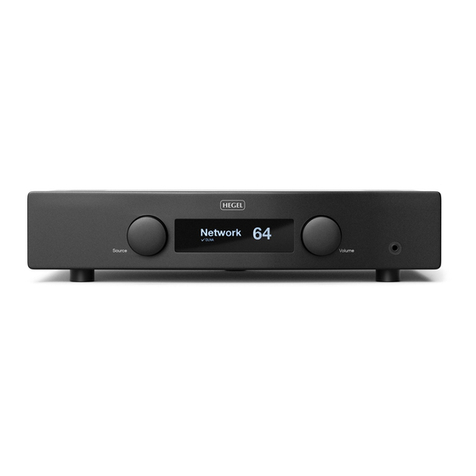
Hegel
Hegel H95 user manual

T+A Elektroakustik
T+A Elektroakustik DD 1535 R operating instructions
